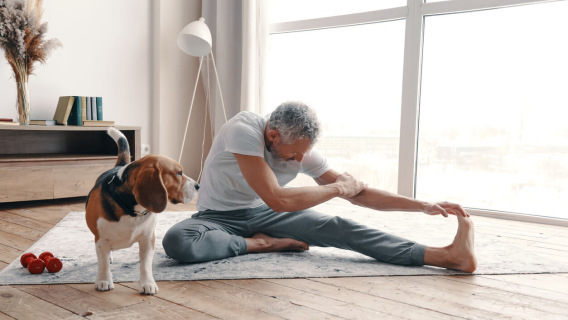Webinar Recap: Exercise for Mesothelioma

Exercise is vital to overall wellness, health and recovery for mesothelioma survivors. Mesothelioma compromises the respiratory system, breathing function and abdominal muscles.
Prehabilitation is the practice of exercising before a treatment. Studies show that it can help patients recover faster after a surgical procedure, chemotherapy or other mesothelioma treatments.
Exercise for mesothelioma patients can improve their cardiovascular fitness and ability to tolerate more treatments such as surgery and chemotherapy. Many survivors also experience poor sleep and increased stress, which exercise can help mitigate.
Physical activity also reduces your risk of chronic illnesses like high blood pressure and diabetes. Limiting the occurrence of chronic co-existing conditions can help you avoid putting extra stress on the body and diminish the chance of comorbidities and complications.
When and How Should I Start Exercising?
One of the most significant hurdles preventing mesothelioma patients from exercising is fatigue. My patients ask me, “How am I supposed to exercise if I am so tired?” Moving around more and finding opportunities for more activity can help you get into the exercise rhythm.
I tell patients that now is often the best time to start exercising. After you get your mesothelioma diagnosis, start your physical activity immediately. Your healthcare providers will work with you to develop a safe and appropriate exercise plan.
People with a habit of working out will have an easier time starting a routine. If you don’t exercise frequently, getting started can be more challenging. Your cancer’s location will also affect how easy it is to exercise. Mesothelioma in the chest can make breathing more difficult, while peritoneal disease can cause pain with core movement.
Some of the first exercises mesothelioma patients should consider are aerobic exercises that work the heart such as walking, swimming or cycling. Resistance exercises can help patients who want to retain muscle mass. Balance, flexibility and mobility routines such as yoga and tai chi are helpful for patients who struggle with these issues.
Exercise is vital during your mesothelioma journey. Learn which exercises can help you feel better and recover faster.
View the RecordingWhat Should I Avoid During My Workouts?
Working out might feel awful in the beginning, but don’t confuse being uncomfortable with pain. If something feels off, for example experiencing a sudden pain in your side, that’s the time to stop and discuss your exercise with your doctor.
If you’re using the gym or shared equipment, remember that cancer patients can be prone to more frequent and severe infections. Always wipe down and sanitize gym equipment before use and avoid crowded gyms. Having someone with you to prevent falls or other injuries is also essential during the first few workouts.
Many people have difficulty telling the difference between shortness of breath, reduced endurance and lower oxygen levels. Using your abdominal muscles (diaphragmatic breathing) is vital. Breathe in through your nose during exercises and push air out through pursed lips to exhale.
Some patients worry about exercising if their cancer has metastasized to other areas of the body. In most cases, exercise is still safe if you’re mindful of pain or discomfort. If cancer is in the bones, we consider more restrictions to prevent bone breakage.
How Can I Target Exercise For Mesothelioma?
Depending on your stage of cancer, symptoms and type of mesothelioma, you can work with your provider to tailor your exercise plan. Patients with early-stage disease benefit more from prehabilitation before their treatments, plus aggressive exercise for cardiovascular health.
Patients with late-stage disease suffer from more fatigue and have difficulty completing their daily activities. Light and frequent exercises can help decrease tiredness and create a more active daily routine. More regular activity can help you feel better and be more active. For example, park the car further away from the store.
Respiration exercises such as strengthening your shoulder and pelvic muscles can help you breathe better and recover faster from surgery and other procedures. Walking around after surgery is also a great way to engage multiple muscles and return to your average activity level.
The primary message for patients is that some activity is better than no activity. At some point, every cancer patient experiences fatigue. Tiredness and fatigue can be physical or mental, but exercise is the best medicine for fatigue. Ask your doctor where to start with exercise, develop a plan and you’ll feel better with a healthier routine.